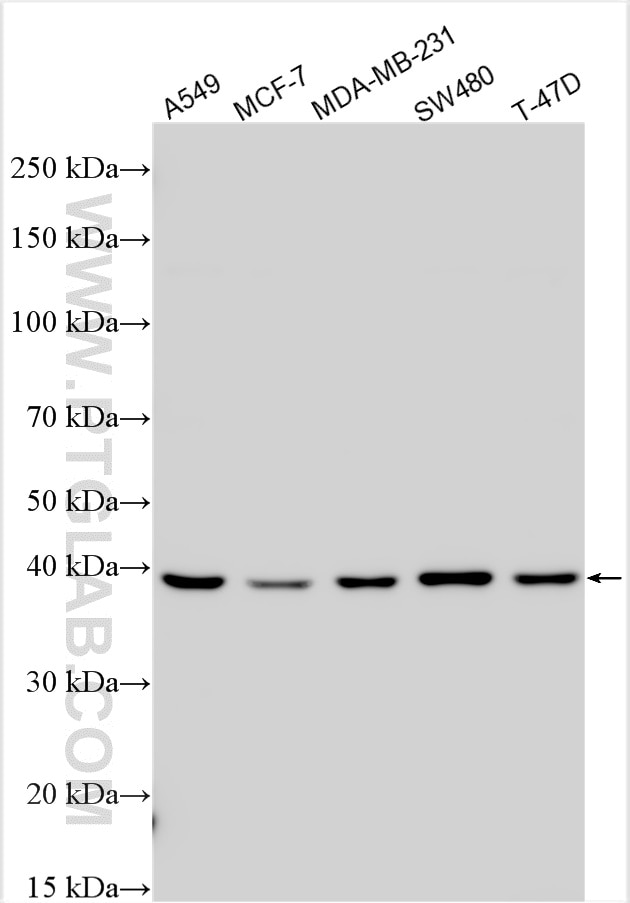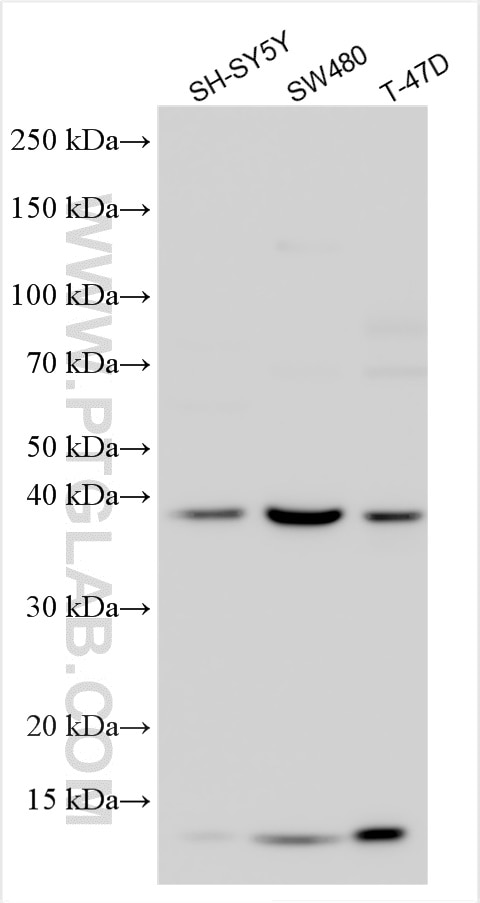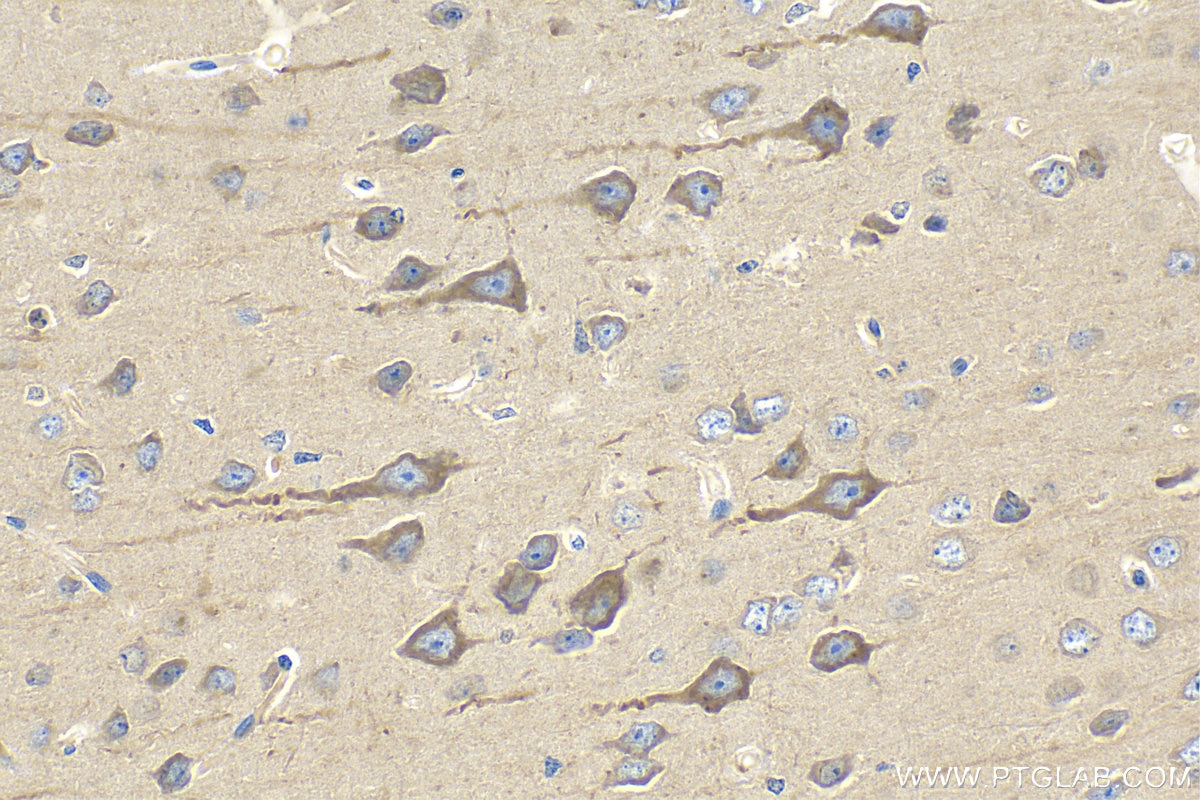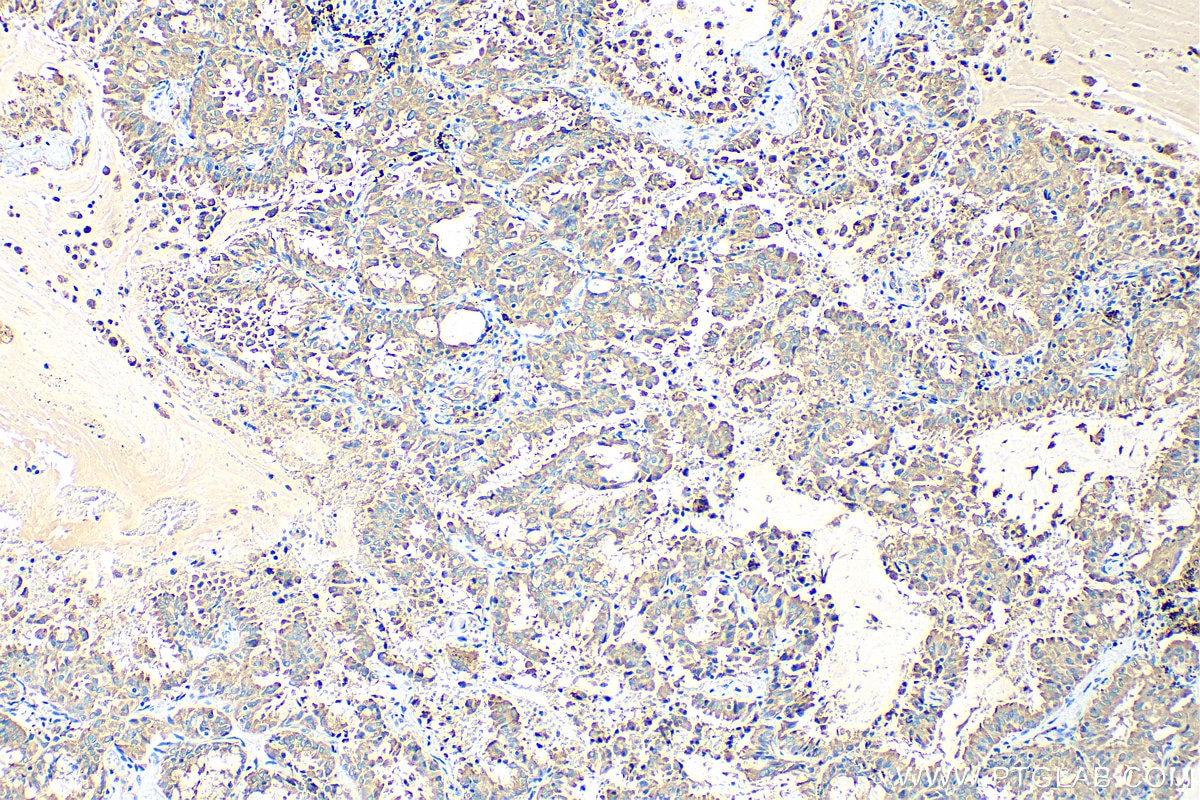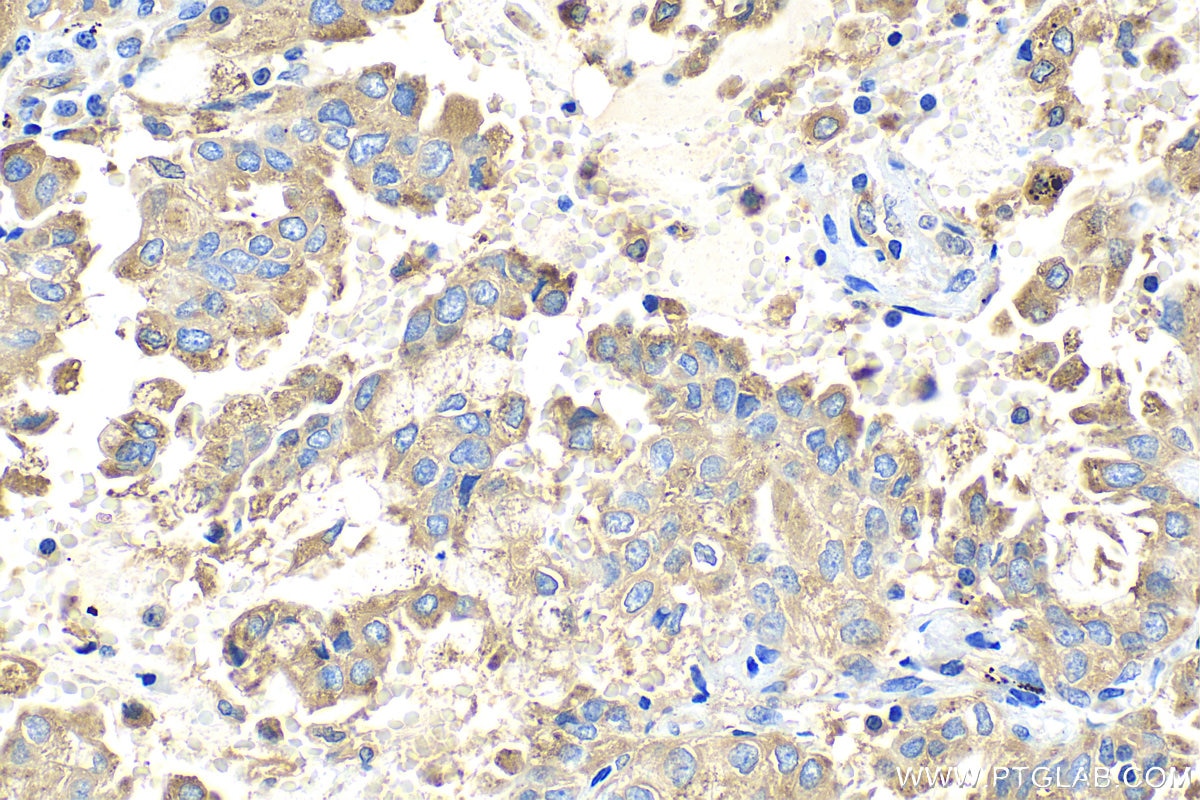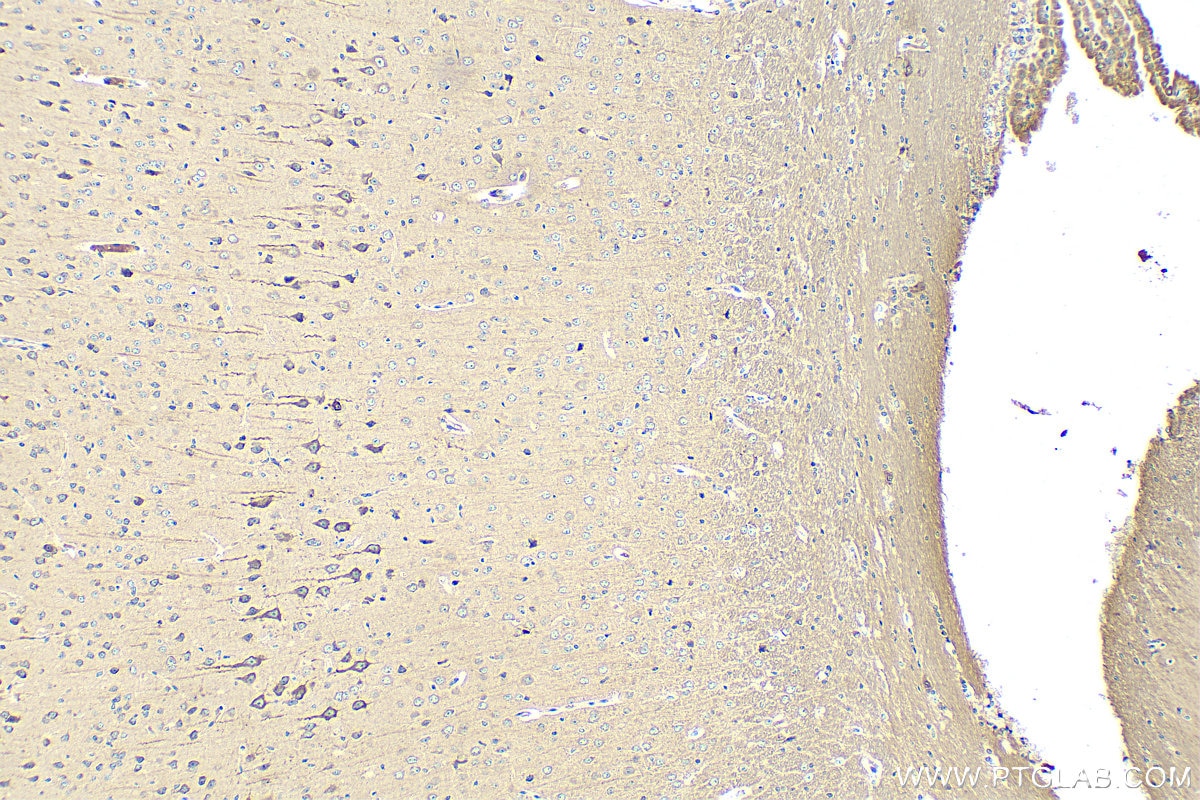Tested Applications
| Positive WB detected in | A549 cells, SH-SY5Y cells, MCF-7 cells, MDA-MB-231 cells, SW480 cells, T-47D cells |
| Positive IHC detected in | human lung cancer tissue, human breast cancer tissue, mouse brain tissue Note: suggested antigen retrieval with TE buffer pH 9.0; (*) Alternatively, antigen retrieval may be performed with citrate buffer pH 6.0 |
| Positive IF/ICC detected in | SH-SY5Y cells |
Recommended dilution
| Application | Dilution |
|---|---|
| Western Blot (WB) | WB : 1:2000-1:16000 |
| Immunohistochemistry (IHC) | IHC : 1:50-1:500 |
| Immunofluorescence (IF)/ICC | IF/ICC : 1:50-1:500 |
| It is recommended that this reagent should be titrated in each testing system to obtain optimal results. | |
| Sample-dependent, Check data in validation data gallery. | |
Published Applications
| WB | See 11 publications below |
| IHC | See 1 publications below |
| IF | See 2 publications below |
Product Information
11274-1-AP targets ASAH1 in WB, IHC, IF/ICC, ELISA applications and shows reactivity with human, mouse, rat samples.
| Tested Reactivity | human, mouse, rat |
| Cited Reactivity | human, mouse |
| Host / Isotype | Rabbit / IgG |
| Class | Polyclonal |
| Type | Antibody |
| Immunogen |
CatNo: Ag1799 Product name: Recombinant human ASAH1 protein Source: e coli.-derived, PGEX-4T Tag: GST Domain: 1-389 aa of BC016828 Sequence: MNCCIGLGEKARGSHRASYPSLSALFTEASILGFGSFAVKAQWTEDCRKSTYPPSGPTVFPAVIRYRGAVPWYTINLDLPPYKRWHELMLDKAPVPGLLGNFPGPFEEEMKGIAAVTDIPLGEIISFNIFYELFTVCTSIVAEDKKGHLIHGRNMDFGVFLGWNINNDTWVITEQLKPLTVNLDFQRNNKTVFKASSFAGYVGMLTGFKPGLFSLTLNERFSINGGYLGILEWILGKKDAMWIGFLTRTVLENSTSYEEAKNLLTKTKILAPAYFILGGNQSGEGCVITRDRKESLDVYELDAKQGRWYVVQTNYDRWKHPFFLDDRRTPAKMCLNRTSQENISFETMYDVLSTKPVLNKLTVYTTLIDVTKGQFETYLRDCPDPCIGW Predict reactive species |
| Full Name | N-acylsphingosine amidohydrolase (acid ceramidase) 1 |
| Calculated Molecular Weight | 44 kDa |
| Observed Molecular Weight | 37-40 kDa |
| GenBank Accession Number | BC016828 |
| Gene Symbol | ASAH1 |
| Gene ID (NCBI) | 427 |
| RRID | AB_2058719 |
| Conjugate | Unconjugated |
| Form | Liquid |
| Purification Method | Antigen affinity purification |
| UNIPROT ID | Q13510 |
| Storage Buffer | PBS with 0.02% sodium azide and 50% glycerol, pH 7.3. |
| Storage Conditions | Store at -20°C. Stable for one year after shipment. Aliquoting is unnecessary for -20oC storage. 20ul sizes contain 0.1% BSA. |
Background Information
ASAH1, also named as AC, ACDase, Acid CDase, PHP32 and ASAH, belongs to the acid ceramidase family. ASAH1 is a lipid hydrolase that catalyzes the conversion of ceramide (cer) into sphingosine (SPH) and a free fatty acid. Mutation of ASAH1 will cause the Farber lipogranulomatosis (FL) which also known as Farber disease (FD). The predicted molecular weight of ASAH1 is 45 kDa. ASAH1 is a glycoprotein processed from a 55-60 kDa precursor via autoproteolytic cleavage into a mature heterodimeric enzyme formed by an α-subunit (13 kDa) and a β-subunit (37-40 kDa) (PMID: 22261821).
Protocols
| Product Specific Protocols | |
|---|---|
| IF protocol for ASAH1 antibody 11274-1-AP | Download protocol |
| IHC protocol for ASAH1 antibody 11274-1-AP | Download protocol |
| WB protocol for ASAH1 antibody 11274-1-AP | Download protocol |
| Standard Protocols | |
|---|---|
| Click here to view our Standard Protocols |
Publications
| Species | Application | Title |
|---|---|---|
Nat Commun Acid ceramidase of macrophages traps herpes simplex virus in multivesicular bodies and protects from severe disease. | ||
Hum Mol Genet Acid ceramidase inhibition ameliorates α-synuclein accumulation upon loss of GBA1 function. | ||
BMC Genomics Lipid metabolism-related genes are involved in the occurrence of asthma and regulate the immune microenvironment | ||
Int J Mol Sci Hyperbaric Oxygen Treatment Ameliorates Hearing Loss and Auditory Cortex Injury in Noise Exposed Mice by Repressing Local Ceramide Accumulation. | ||
J Dermatol Sci Th1 cytokines accentuate but Th2 cytokines attenuate ceramide production in the stratum corneum of human epidermal equivalents: an implication for the disrupted barrier mechanism in atopic dermatitis. |

